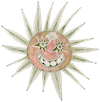Form of Travel
Consider the dandelion.
Even though they are identically programmed, fated to a fixed expression by apomixis
>
their survival depends on being radically open to chaotic energy: to whim (the wish-filled breath of a lover) and chance (the fur of a passing animal) and the ritual of deep time’s slow dance.
Taraxacum Officionale is an emblem of expansion, abolition, resistance and whatever it might mean to be free.
But what even is ‘free’?
There’s a definition I like from a book a new friend gave me for my birthday, it’s called Joyful Militancy by bergman and Montgomery:
“Freedom and friendship used to mean the same thing: intimate, interdependent relationships and the commitment to face the world together.”
And that in turn reminds me of the fluff of a taraxacum’s achene.
Holding formation tighter than a phalanx of backup dancers.
Softly touching on to one another until the appointed hour.
When the dandelion clock strikes ‘now’..
And they are released.
Into infinity.
And these kin do not become unlinked at the time of dispersal.
Instead they retain the freeing-bond. Of time shared while growing together in solidarity.
And that connection is enshrined epigenetically. As survival skills, strength in numbers and trust that the wind will carry us to where we need to be.
All I’m trying to say here is, friendship is the root of freedom and my friends are my family. And right now we are dispersed all over the planet, scattered by fate or old fossil-fuelled passing fancy. And I’m locked-down here by more than gravity, wishing for kin who live more locally.
And one of these is Leila Dear.
We met in the light of a bonfire, caught each other en route at odd hours, on the road in the rain and twice mudlarking by the Thames. And even though we’ve always been moving, I never noticed because good company carries a person and makes light of the body. And that is one of the things that has really been helping me recently.
Especially in a pandemic which for many has been disembodying and lonely. And even if we can’t travel right now so easy, these fractal dérives with Leila (heavily pollinated with hyperlinks) have been a lesson (at least to me) that conversation can be used as a method of transport, communication is a vehicle that moves us from A to B, and wishes are a mode of travel from now to wherever we need to be.
Literally.
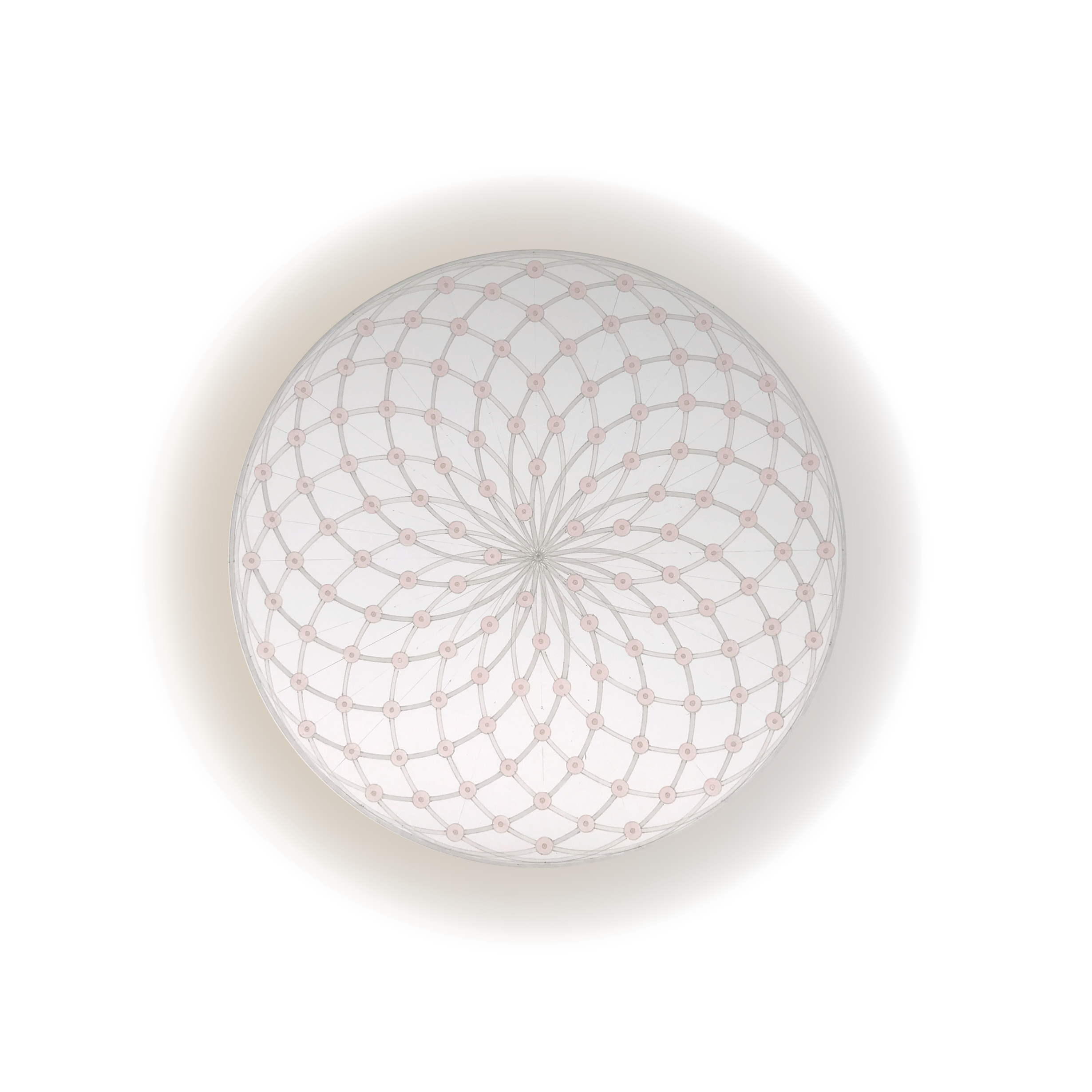
SAM: Leila, you know a lot about mathematics and floral geometry.
Can you help me understand this story about a new form of aerodynamics they discovered in a dandelion seed?
LD: Well, it is a type of aerodynamics that had not been observed before, but is happening all the time. An unattached vortex. It was thought impossible to find in nature because it is too unstable. It threatens to collapse in on itself as soon as it forms. The type of vortex that helps a wing or maple seed fly is in contact with that surface, which separates two different flows of air. The unattached vortex floats above the dandelion seeds bristles, hanging in a delicate equilibrium. It is sustained because of the particular features of the pappus disk, always between 90 – 110 bristles, lots of empty space, 90% air. The research suggested the most useful part of its structure is the empty space, holding empty space helps to stabilise the vortex. It’s a good metaphor for meditation.
SAM: So basically, a wish is a form of travel?
LD: It is!
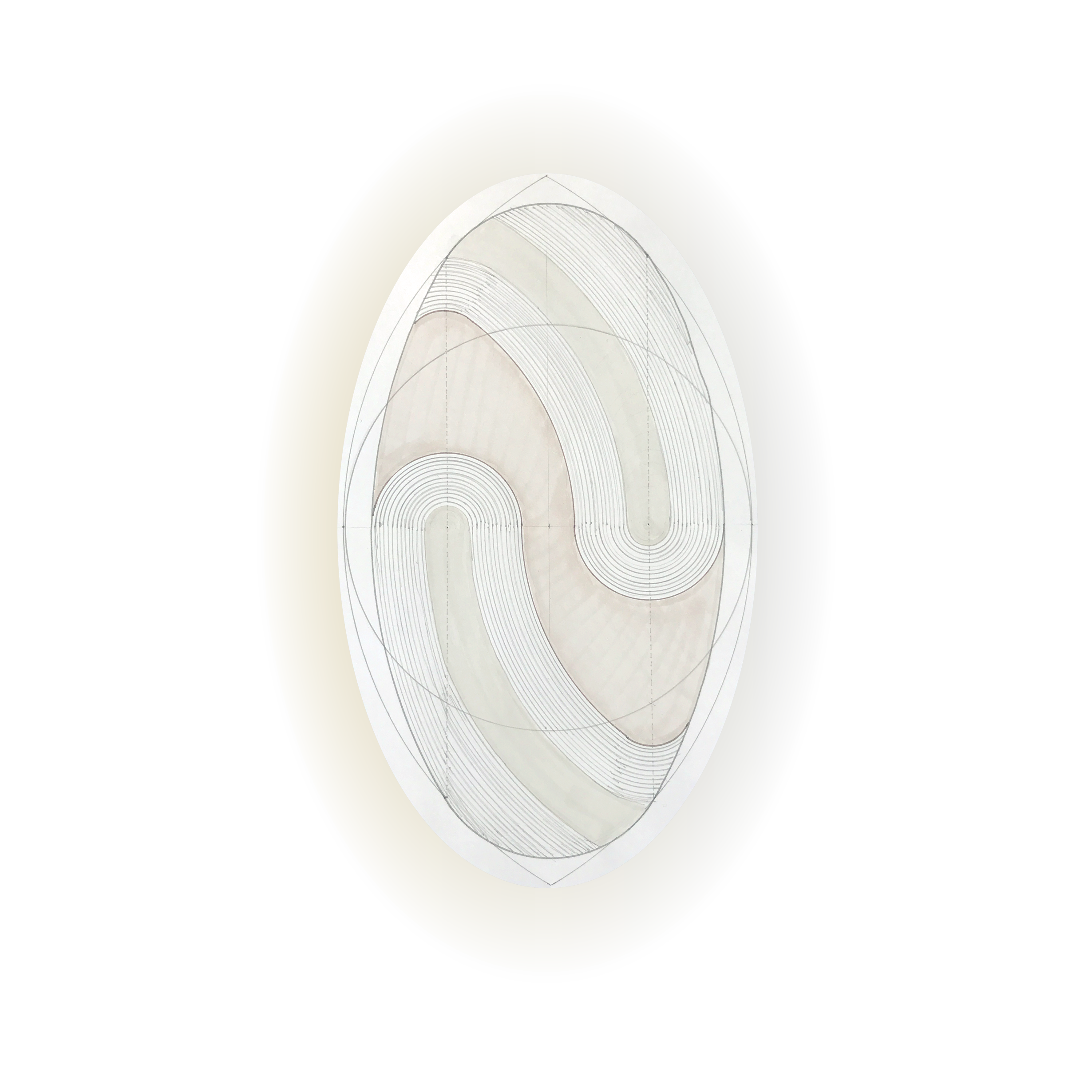
SAM: And this is a drawing based on the photographs from that experiment?
LD: Yes. I was looking at the vortex that is produced just above the pappus of the dandelion achene. The vortex looked like it was roughly contained within this shape which is called a ‘Vesica Piscis’, which means the fish’s bladder. It is also known as an almond or Yoni shape. You see it in many churches and the figure of Christ will be enclosed in it. He’s emerging from the cosmic yoni.
SAM: Is that where the fish thing with Christ comes from?
LD: Yeah.
SAM: Had to look it up. Wow. Ichthys? Wait, it turns into an asterisk! That is going to become very important to this project’s larger body. Chills! Jeez. If I’m turning into Dan Brown here, somebody come get me.
LD: Pattern recognition is interesting when you feel it in your body.
SAM: These days I barely feel my body. I guess yoga helps. You tried any breathwork? What’s it called? Pranayummy?
LD: You mean pranayama. Yeah. I’ve tried it in a couple of different contexts. Yoga and Hesychasm, which is an Eastern Orthodox practice of rhythmic breathing and mantra. I’m curious about how our conscious mind is able to direct something which is usually unconscious. Bringing about a change of state, mood or long term health. It's interesting that we start to create certain rhythms due to stress or tension that compound themselves and that you can reverse engineer a sense of calm by mimicking the rhythms of a tranquil state of mind. Body over mind rather than mind over body.
SAM: I really want to get into these dandelion drawings you’ve done that are floating around here. They’re a part of the larger collaborative project of taraxos, a sort of exquisite corpse palimpsest. I invited you to riff on the flower and create a portal and you came back not with one but with many. Can you tell me what your process of making these was?
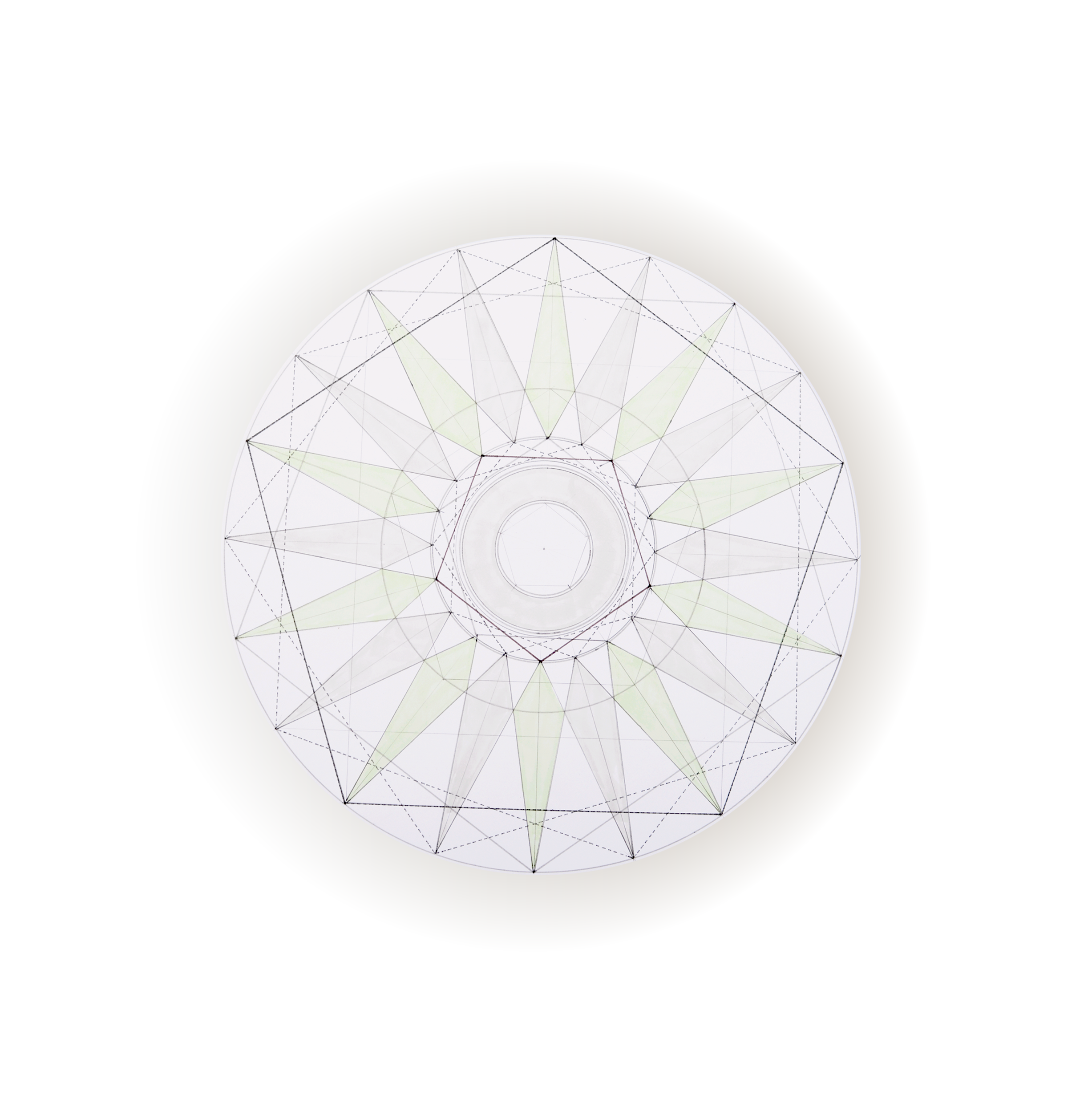
LD: The dandelion drawings started by looking at its different phases of existence as flowering plant and dandelion clock. The flowering head of the dandelion has loads of petals. Too many for me to be able to construct some meaningful geometry. But there are clues to its underlying structure in the bracts that support the flower head. On average there are twenty. Twenty is divisible by five. Five points equally spaced apart around the circumference of a circle gives us the pentagon and golden ratio proportions. I worked with twenty divisions of the circle to represent the channels along where the seeds are distributed. They need to be spaced out evenly around the seed head. Nature has figured out the most efficient way of doing this so that there is no unused space on that small compressed sphere, and so each papilla has the best chance of launching off, powered by its own vortex.
SAM: And they’re pretty big irl. What is the significance of the size?
LD: I like the idea of a relative measurement. It rings true for me that the guide or map to a specific body is inscribed in that body. The width of your thumb is one cùn. The chinese inch. The distance from the elbow crease to the wrist is presumed to be twelve cùn. Your cùn is different from my cùn. These measures are traditionally taken as a guide to locate meridians or energy channels on your body. An acupuncturist might try and locate a specific point that is 2 cun above the patient's navel to stimulate a meridian. That is how I encountered the measure, on an acupuncturist’s table. It reminded me of compass and straight-edge constructions. The radius of a circle perfectly divides its circumference 6 times. The process of simply drawing a circle with a compass reveals pattern and the relationship between its parts.
So these dandelion ports have now been sent to Tosh Basco who will work with them for the next stage of taraxos. They are made to measure to Tosh’s cùn. Each division for the seed channels are 4 ‘Tosh cùn’ apart.
SAM: They’re so complex, How do you make these?
LD: Would you like to try a simple version?
SAM: Ya!
LD: OK. There’s your horizon line. Place your point. Draw a circle.
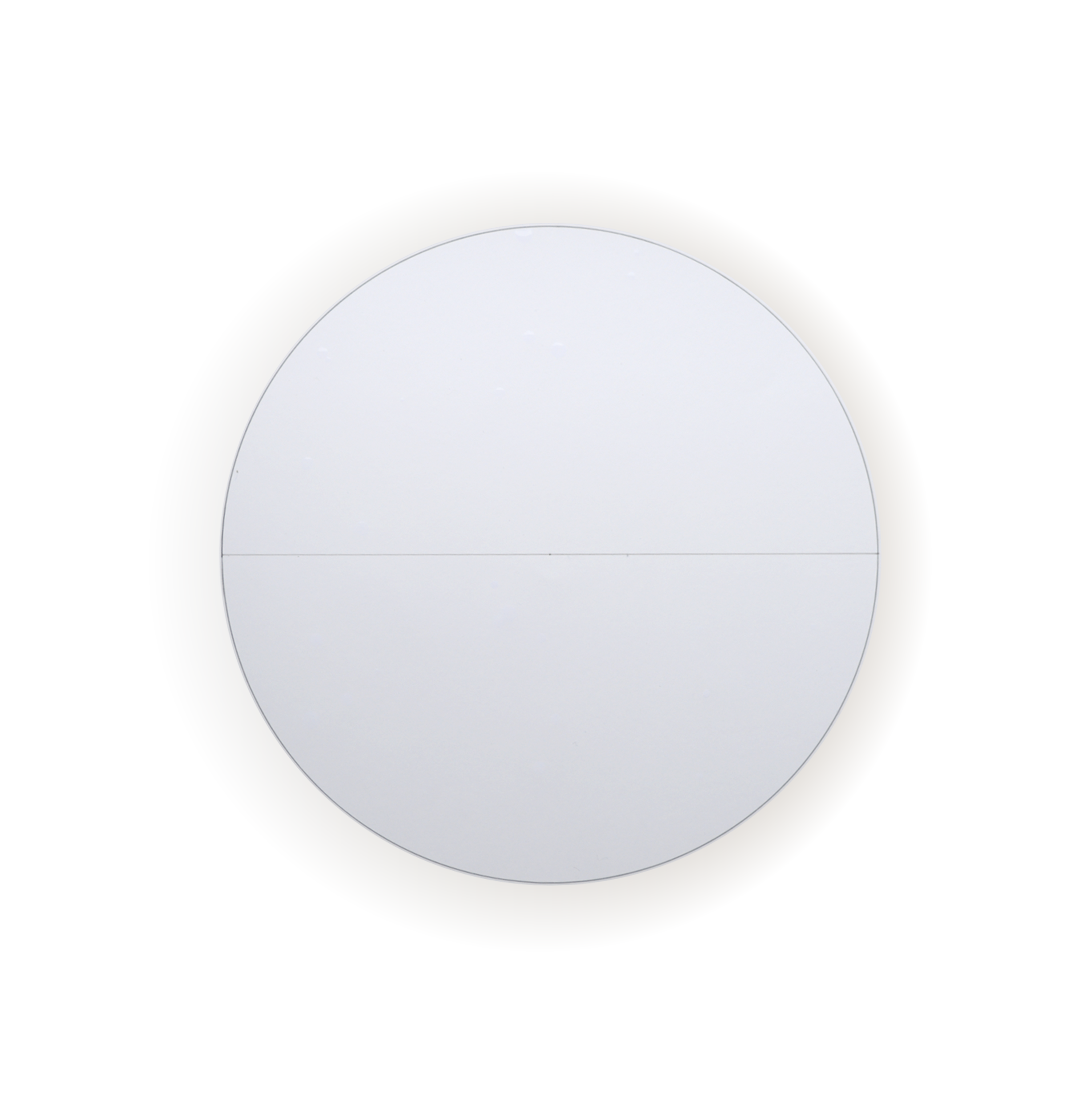
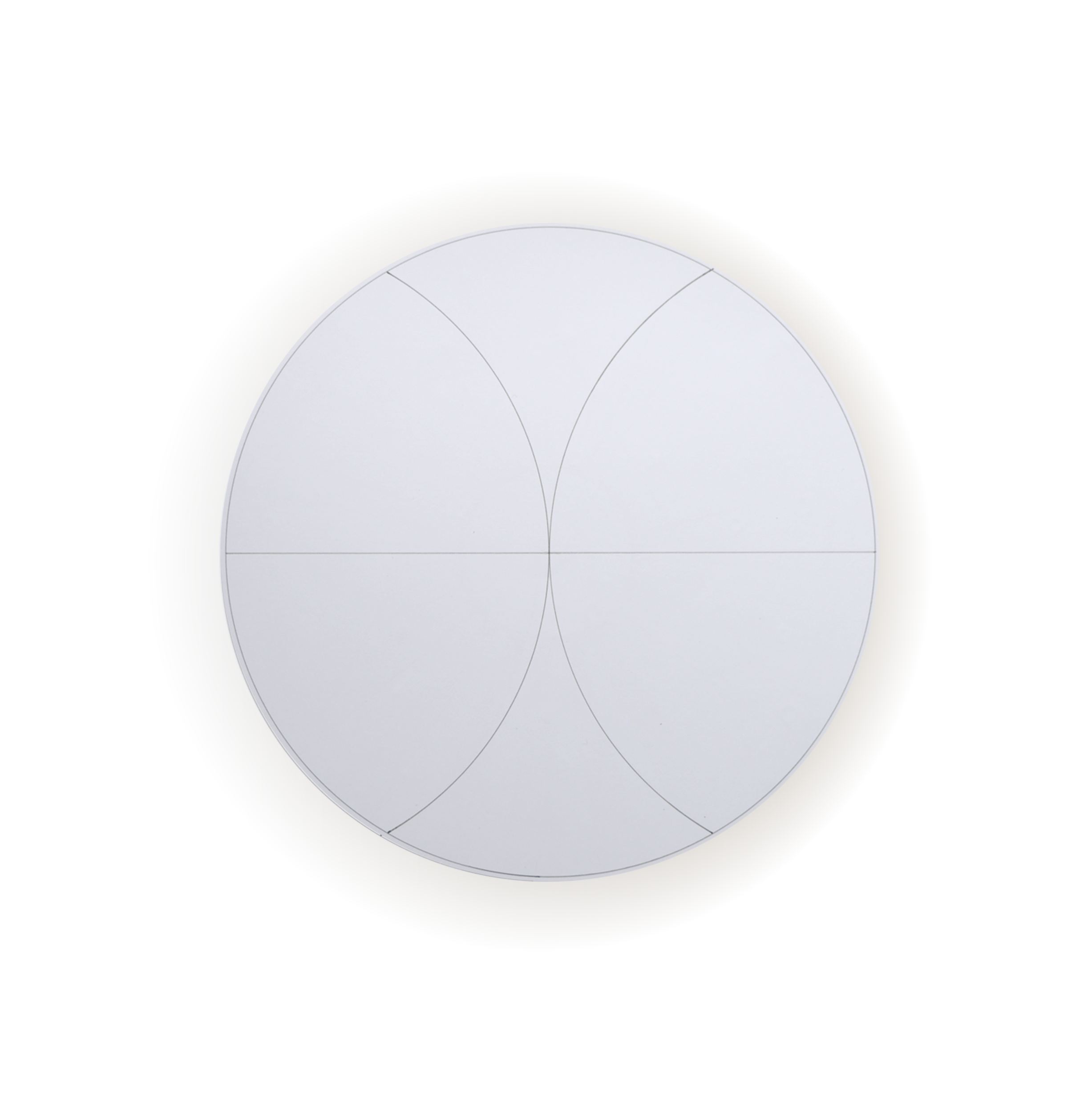
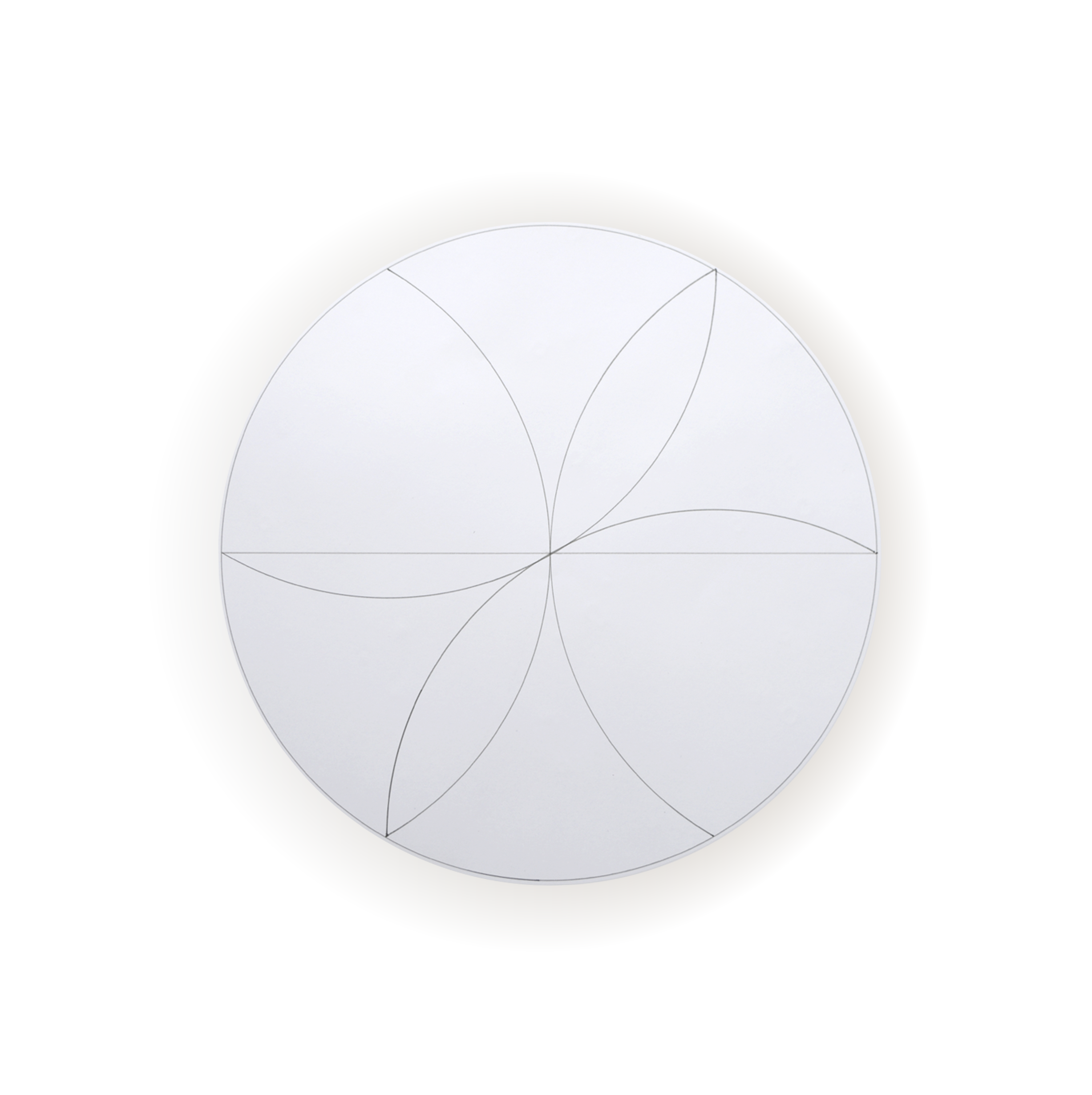
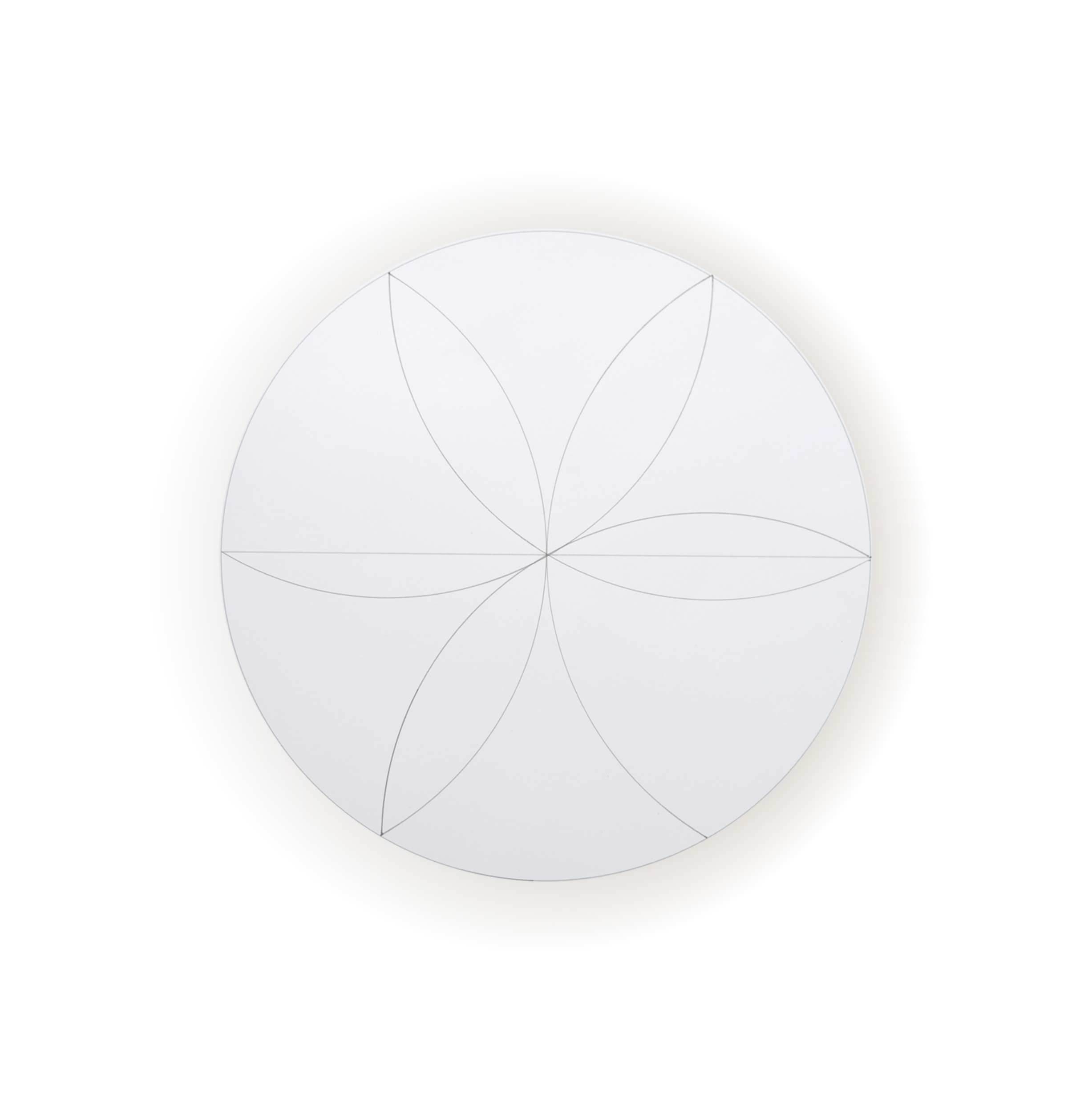
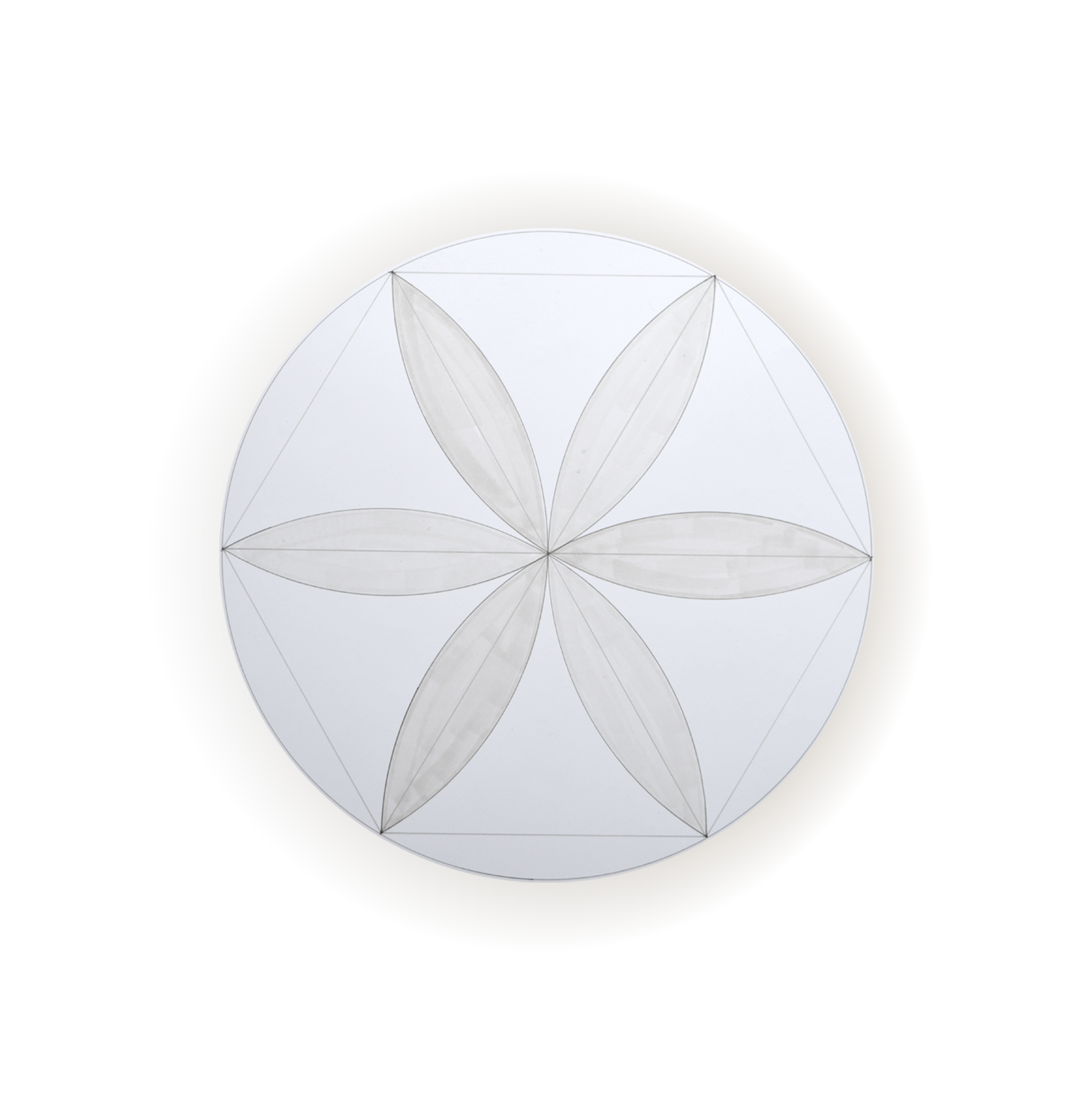
LD: And then you have your ‘Flower of Life’. Around those petals you can connect up the corners and find you have a hexagon. That Hexagon, with a few simple lines already embedded in this diagram, can be divided up into recognisable Islamic geometric patterns. It’s so easy, it's right in front of you, the relationship between a radius of a circle and its circumference. You take advantage of that to create tessellations and patterns.
SAM: What is the origin of this symbol?
LD: Everyone's played with it all around the world. Spend some time making marks with rope and something to scratch or draw with and you will discover geometry. I guess that's the thing about maths, you can see it as innate.
SAM: Is that what people mean by ‘Sacred Geometry’?
LD: The term ‘Sacred Geometry’ merges all the different world traditions, which have used geometry to point to unity and/or transcendence. Or divine mind. The idea is a creator consciousness has made use of these mathematical patterns that we can observe and learn from, in order to structure the cosmos. No culture can claim any particular ownership of these patterns but there are flavours or styles that take hold in certain places and become recognisably part of that region's aesthetic language. There is plenty of cross-pollination where geometry and symbolism travels from one side of the world to the other.
A good example is the ‘three hares’ pattern found in the Thousand Buddha Grottoes caves of Mogao, China. It is a remote place on the borders of the Taklamakan desert. In the year 800 the motif was painted in several points throughout the 700 rooms of the cave system. At the time that region was a melting pot of cultures. The pattern travelled along the Silk Road and made its way into Europe. Eventually it became a popular motif in church roofs in South West England where it is known as the ‘Tinners’ Rabbits’ from the local tin mining, I guess. A couple of years ago, I was in Durham and saw three men practicing a Morris dance in front of the cathedral. They had their arms all interlinked in front of them, and gripping each other’s hands. They were skipping round and round in circles. For some reason I felt like I had to ask about the dance. They told me it was the Tinners’ Rabbits dance. It set me off thinking about geometry and dance and embodiment. Geometry is everywhere. If you look you'll see it.
SAM: What does looking even mean though? I guess drawing…?
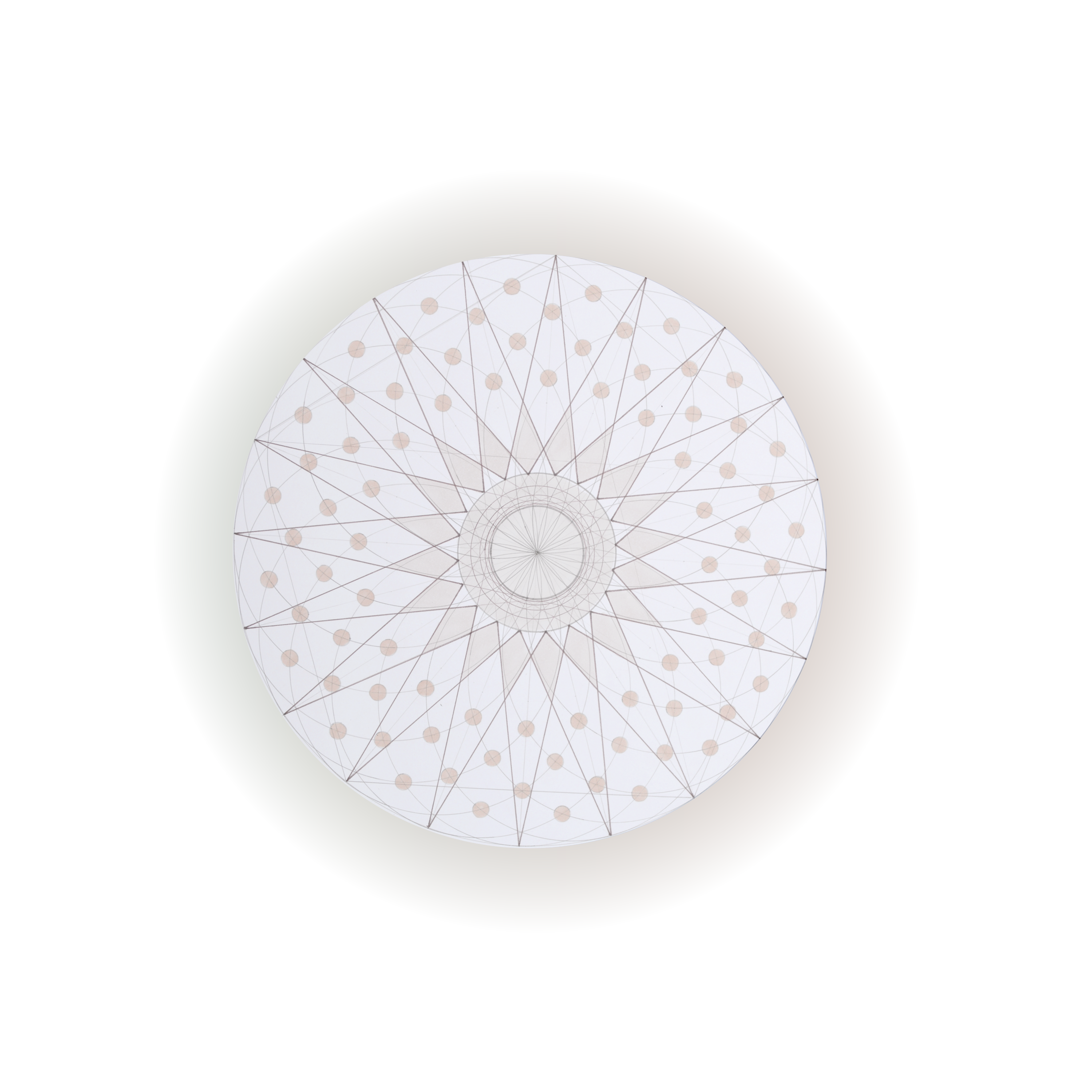
LD: Yes, you need some practical familiarity with it. To experience how it unfolds for yourself. Head, heart and hand. You could draw. You could apply a rule, say you're limited to this fixed instrument, a rusty compass, and all you can do is just draw circles of this particular radius and you'll soon discover just through playing that you create the shape we just drew. Or you could use sticks and explore how it works in three dimensions.
SAM: What would the 3D equivalent of this be?
LD: There isn't an analogue with this one actually because something weird happens between two dimensions and three dimensions where hexagons don't exist as a regular tiling in three dimensions. Instead we have pentagons.
SAM: Woah. So does that mean that there's another dimension between? Like a half-floor between floors?
LD: There is something weird that happens between a hexagon and a pentagon. I don't know how to articulate it though. It’s like there is something that's lost between the dimensions. There is a strange relationship between the dimensions. There is a Fibonacci number pattern that runs between the numbers of regular and semi-regular tilings that are possible between the second and third dimension. I've been trying to understand four-dimensional geometry recently, but I get slight glimpses of what that means and then the whole thing collapses.
SAM: I guess we're like squares in Flatland. We can't conceive of it. If you can't, who can?
LD: Mathematicians.
SAM: There’s definitely something that tickles the ‘God spot’ of my brain in all of this.
LD: I did this Icon Painting course based on the Prosopon school style. They have this technique where they need a texture in a painting to look like it was not made by human hands. And so what they do is they mix the egg tempera with bits of grit and dust so you just splodge your brush filled with grit and dust over your gesso panel which creates this effect of unmade-ness.
SAM: So it adds chance?
LD: Yeah. To add chaos to the brush lines you throw in dust and grit that break up the texture of the egg tempera and this is something that's used for certain symbolism in the icon paintings.
SAM: Literally adding his dark materials...
LD: What did you feel drawing the ‘Flower of Life’ earlier?
SAM: It felt really good. Kinda calming.
LD: Geometry is like that. Dimensional healing or something. Touching the things we can't quantify or can't talk about. That was quite a simple construction, but you have a sense of satisfaction of it all coming together. When you start to get into more complicated realms, you can create patterns that you might recognise, that you've seen before in a mosque or church, and could never imagine how to even begin to construct such a tessellation. They can be dizzying, you can look at these wonders of the world and feel totally alienated. How were they made? What state of mind were the artists in when they created or discovered these forms? Actually, you can sit down with just a compass and a ruler and recreate it yourself and when you do you get a gut punch sense of epiphany. It all comes together in a vaguely spiritual feeling but also comprehension. This practice, of following a set of rules and reaching a beautiful outcome, a resolved pattern, satisfies your intellectual and aesthetic sensors and moves our other sensors too.
SAM: That really reminds me of this Spirograph drawing I have hanging in my room that Tosh drew. It feels like a series of partially-formed portals. I think I see what you mean about geometry being healing. Whirling and spinning of a spirograph can be such a meditative thing and an escape from this meatspace dimension at least psychically.
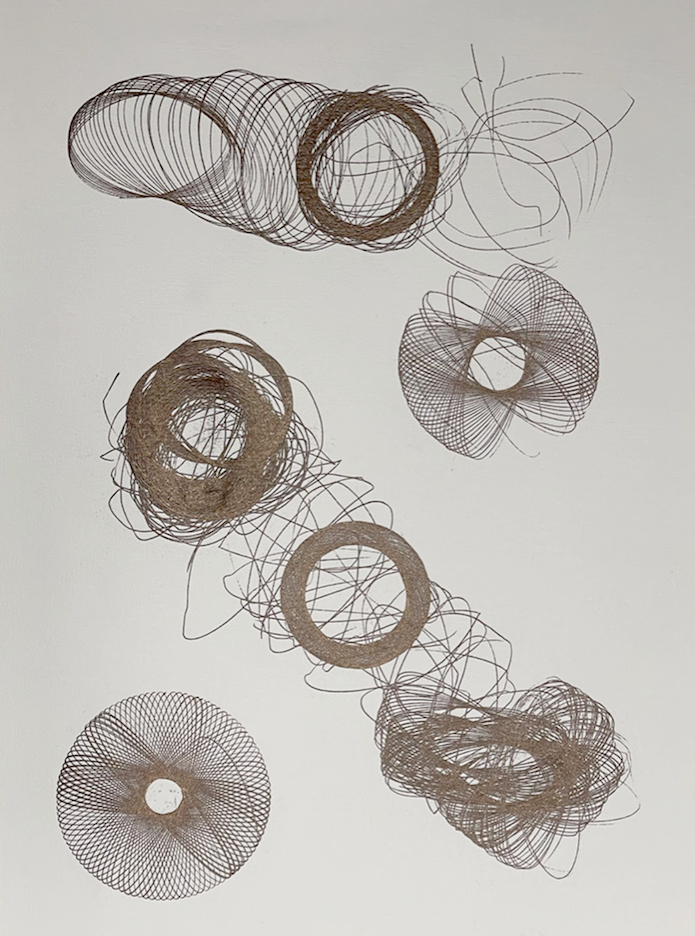
SAM: Tell me more about the divine intelligence in nature’s geometry thing though, because I've never heard that really before getting into this dandelion wormhole.
LD: I think you can have quite a grounded interpretation of ‘divine mind’. It doesn't need to be supernatural or imagined as something resembling human consciousness. It can simply be acknowledgement of the stable mechanics of the universe. Because we are able to make accurate predictions about the nature of reality, we can create miraculous instruments and send probes to other planets. The stability of those observations is arguably based on geometry. The behaviour or characteristics of molecules is dependent on geometric structuring.
I spoke to a physicist who told me there was some research on subatomic particles that challenged the idea of space and time as fundamental components of nature. A new jewel-like shape had been discovered in 2013. It is called an amplituhedron. The maths is way over my head but from what I understood this new model simplifies calculations of particle interactions. It made the work of the physicists much more efficient. They could even do calculations on paper they had not been able to do with computers. I guess what I took from it is that geometry is still providing new tools, which describe reality better than previous models and the reason we know they are better is that they are more efficient.
There is a sense of intelligence about geometric structures and not necessarily that something intelligent created them but maybe that they are consciousness itself. That structure is consciousness and that we are built up from that underlying or innate consciousness of matter. I guess this ties into Panpsychism.
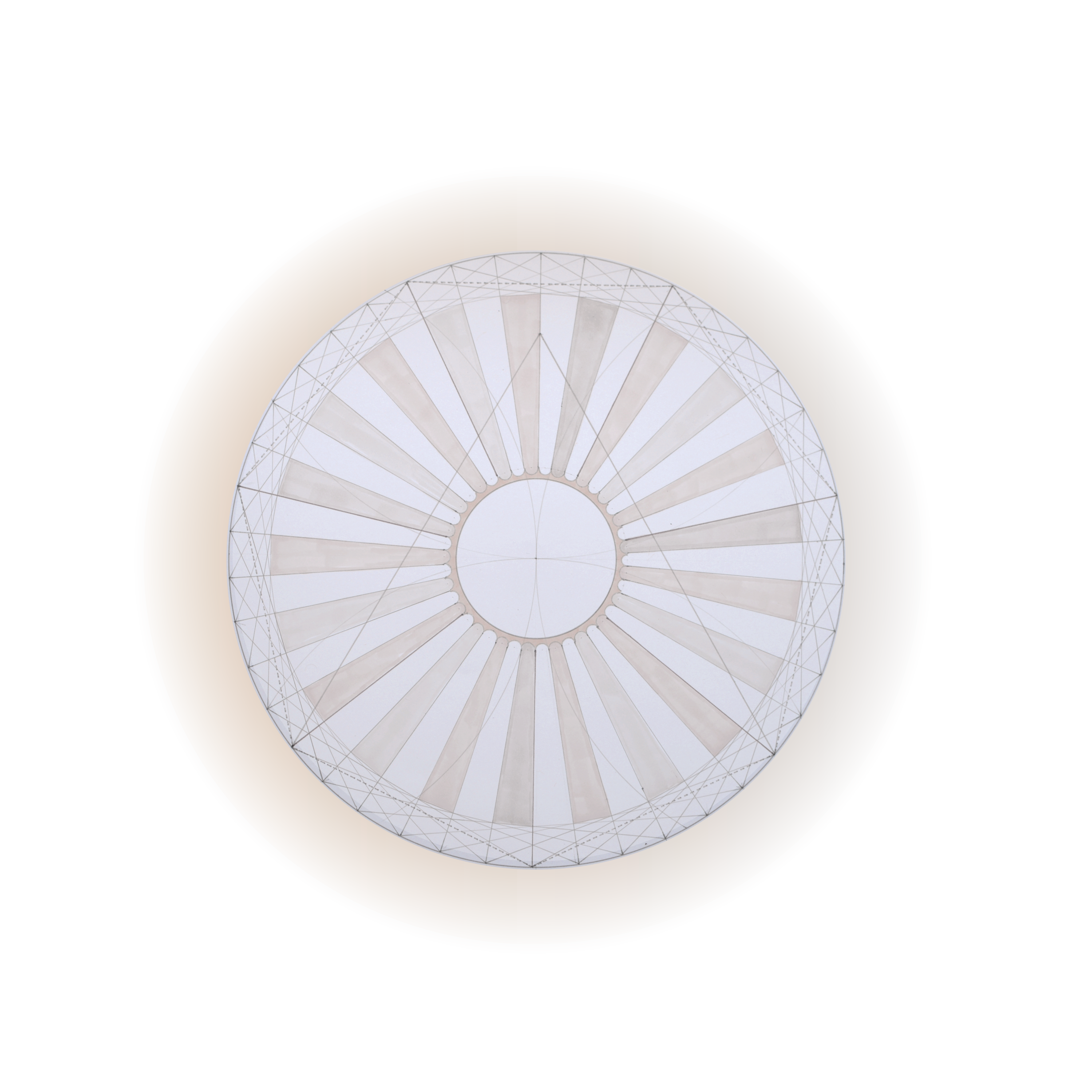
SAM: What’s Panpsychism?
LD: Panpsychism is this theory of mind that actually – God this really is getting fractal – it’s a theory of mind attempting to answer the hard problem of consciousness. Where does it come from? How do you get something from nothing? The idea is that actually you don’t. It’s materialist, you can't get something from nothing. Consciousness already exists. It already exists in all stuff. So in Panpsychism, matter itself has consciousness. At least that's how I’ve understood it. A crystal has consciousness. Not in a hippy way. But in the sense that for anything to exist and have structure, there's a self organising ‘mind’ inherent in it and that we are just an elaboration of those forms or processes.
SAM: Elaborate elaborations.
LD: Yeah and so consciousness exists as structure in the fabric of the universe and it just becomes more and more developed and capable of self awareness as it evolves.
SAM: One big part of this taraxos project for me has been excavating the longing to be near those who are far away. To be able to travel physically and be ‘in body’ with loved ones. How are your astral and physical bodies holding up?
LD: I've had a hard time being embodied, particularly this last year. And it's so necessary to be embodied. I think that's what keeps getting forgotten. It comes back to the breathwork. The body can guide the mind. There isn't being without embodiment. The idea that you could do away with some of the tactility and physicality of existence and go into virtual worlds and exist digitally and upload your brain or whatever sort of fantasies that you want to devise about what's possible with technology…you'll never escape our necessary physicality. Take the idea that we could or should go to Mars that the billionaires are fixated on; on the way there, our bones will wither, our muscles atrophy. I don't believe in that project, I don’t believe we make sense anywhere else.
SAM: It’s hubris.
LD: It’s Icarus.
SAM: The Icarus Miscalculation....sounds like a good pulp sci fi... If we could fly, unlike Icarus and travel by wish tonight, I'd wish us to Shiraz for the spring equinox. We could visit Hafiz's tomb on Nowruz and jump over fires and drink our dandelion wine and pour him a cup too.
LD: A vortex flight to Shiraz would be sublime. Have you seen the video of the jet pack rescue service in the Lake District? That's how I imagine it would feel. Fast but only a few metres above ground. Gliding over the contours of the landscape.
SAM: Kind of like the Night Journey..
LD: The Hafiz tomb is relatively new. Built in the 1930's by a french architect over the site of a previous memorial. The architect apparently did a lot of work to replicate the style of Safavid geometry and cut tile ornament. It has an octagonal dome and geometric tiling on the under side. It might be referencing the Dome of the Rock. I learned the octagon represented a transition between the earthly and the celestial. The earth is symbolised by a square in many traditions. The circle or sphere represent the heavens. The more sides a polygon has the closer it gets to circularity. Geometrically, you can say the octagon having more sides compared to the square, embodies a midway point between the two realms. I think that is how it is used here.
SAM: That brings us back to where we began. The end.































